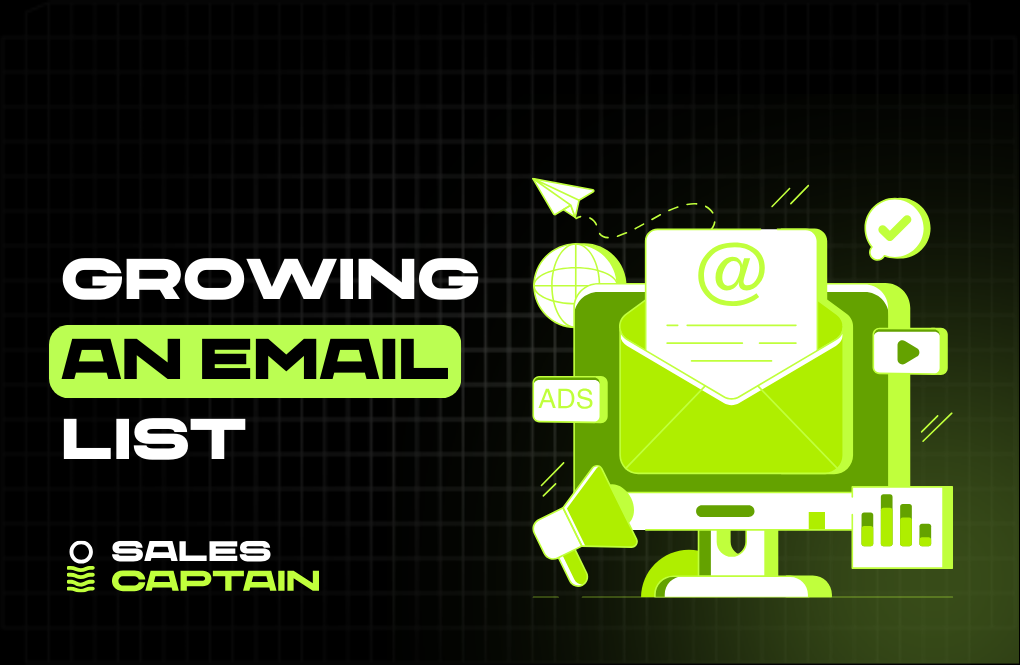

Inbound-Led Outbound: How to Combine Inbound Signals with Outbound to Scale Pipeline in 2025

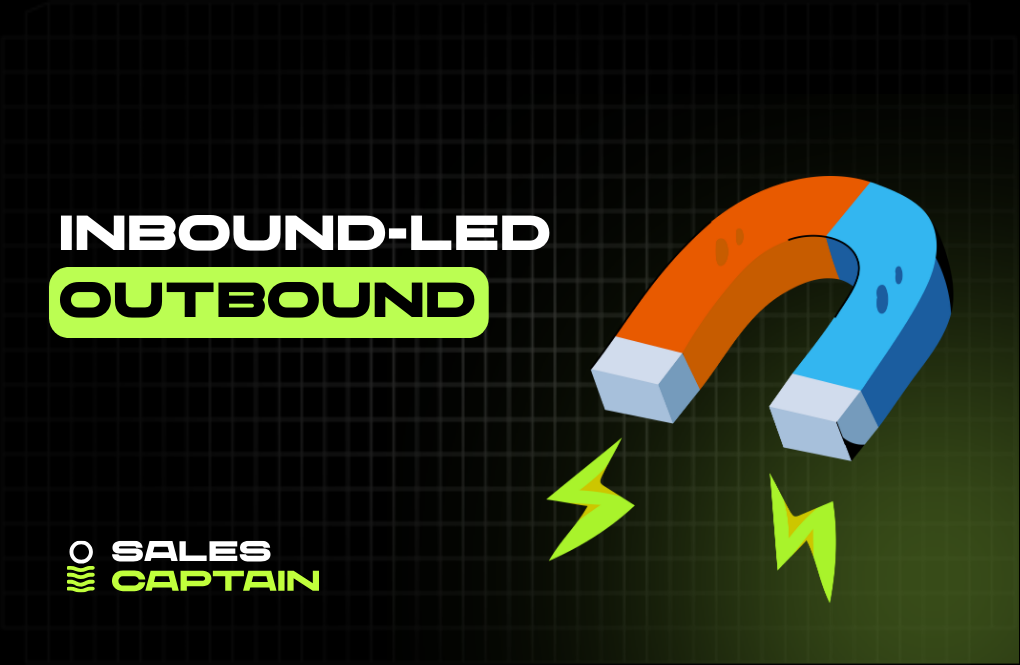
B2B sales have changed dramatically. Buyers don’t wait for cold calls anymore, they research quietly, compare vendors, and form opinions long before they ever talk to a sales rep. That shift killed the old outbound playbook of mass lists and templated emails. At the same time, pure inbound isn’t enough either; it’s too slow to generate pipeline on its own.
The winning motion today is inbound-led outbound, a system where content and brand generate signals, and outbound teams use those signals to trigger precise, contextual outreach that feels timely instead of intrusive.
Why Inbound-Led Outbound Matters Now
Changing Landscape of Lead Generation
Cold prospecting isn't dead, it's just evolving. Buyers don't answer unknown numbers or reply to generic intros anymore. They're researching on their own, reading reviews, comparing vendors, scrolling LinkedIn.
So if your outbound plays aren't backed by inbound signals, intent data, content consumption, firmographic shifts, you're aiming blind.
Inbound gets you discovered. Outbound turns interest into action. But the line between them is gone. It’s not content or calls anymore. It’s both, working together.
And AI has flipped the economics. Now you can scrape, score, segment, and personalize at scale. Which means outbound can finally act like inbound, relevant, timely, and aligned with buyer context.
That changes everything.
Importance of Integrated Strategies
Your buyer doesn't care which channel your message came from. They care whether it's helpful, personalized, and arrives when they need it.
Inbound-led outbound solves the fragmentation problem. It connects marketing and sales workflows so that every touch builds on the last one, your SEO-optimized blog post that ranks for a pain point connects to a personalized LinkedIn DM that starts with insight, not noise.
Without this integration, outbound becomes spam. Inbound becomes passive. Together, they become a signal-powered revenue engine.
This isn't just strategy, it's architecture. You need systems thinking, not silos. Every channel should be part of the same loop, collect signals, create intent, convert with context.
Outbound is now a marketing motion. So marketing and sales need to speak the same language at every layer of the funnel.
Defining Inbound and Outbound Sales
Characteristics of Inbound Sales
Inbound sales starts with attraction. The prospect finds you, through a search, a piece of content, a referral, a case study. They’re already aware of the problem. Maybe even halfway to solving it.
Inbound sales is consultative. You're not pushing, you're guiding. The sales motion aligns with their journey, not your quarter.
It's powered by assets: blog posts, videos, whitepapers, community, webinars, product-led growth. And it scales well, because great content works while you're asleep.
But it depends on visibility. No distribution, no pipeline.
Characteristics of Outbound Sales
Outbound sales flips the motion. You're finding the prospect. You identify the right accounts, reach out directly, and start the conversation before they even realize they have a need.
Historically, this meant SDRs dialing down lists all day. Today, it’s a blend of signals, tech, and timing. Done well, it creates real buying intent on the spot.
Outbound is controlled, targeted, and fast, but risky if not connected to real context. That’s why AI, automation, and market data are making it less spray-and-pray and more precision-driven.
It’s no longer just human touch, it’s systems-led targeting.
Key Differences Between the Two Approaches
Inbound is passive. Outbound is active.
Inbound is about attracting with value. Outbound is about disrupting with insight.
Inbound seeds awareness. Outbound triggers urgency.
Inbound takes time to build. Outbound scales fast, but only when precise.
Different plays, different timing, but the same buyer.
The real unlock is not choosing between them. It’s stitching them together.
Examples of Each Method
Inbound examples:
- A prospect reads your comparison blog post, signs up for a webinar, and books a demo.
- A marketing video ranks on YouTube, leading to an email opt-in and nurture path.
- You publish a case study showcasing results for a specific use case. Prospects in that niche self-identify and reach out.
Outbound examples:
- You use firmographic filters to find companies that just raised Series A, then send hyper-targeted cold emails referencing their market.
- You scrape LinkedIn for job changers in your ICP, feed them into a sequence with a campaign tying to their new role.
- You DM a Head of RevOps responding to something they liked on a shared connection’s post, then follow up with a personalized demo invite.
The best examples? They start with inbound signals. Then move outbound with timing and purpose.
The Rise of Inbound-Led Outbound
Historical Context and Evolution
Outbound used to be brute force. Volume over value. SDRs hammering phones. Personalized emails that weren’t really personal. It kind of worked, until buyers got smarter.
Then came inbound. SEO, webinars, ebooks, email nurture. Less intrusive, more scalable. But also slower. And it depended on people finding you first.
Now, AI and data make outbound smarter, not louder. Instead of hundreds of cold DMs, you trigger outreach based on inbound intent, content viewed, tools used, category behavior. Suddenly outbound becomes contextual.
That’s the evolution. From siloed motions to coordinated plays.
Inbound builds the foundation. Outbound activates the opportunity.
Benefits of Combining Approaches
When inbound fills the top, outbound qualifies and closes faster.
When outbound identifies demand, inbound supports with content and nurture.
You shorten sales cycles, increase response rates, and remove friction from the handoff between marketing and sales.
And because outbound is now driven by marketing signals, page visits, ad clicks, product usage, you get higher precision without the guesswork.
This also lets you do more with leaner teams. No bloated SDR orgs. Just operators running workflows across tools, channels, and moments.
It’s efficient. It’s scalable. And it’s measurable from day one.
Market Trends Supporting Inbound-Led Outbound
A few macro shifts are forcing this change:
- AI makes data extraction and personalization cheap and fast.
- Buyers aren’t filling out forms, they’re lurking, clicking, and researching silently.
- GTM teams are smaller, more technical, less segmented.
- Tooling stacks are consolidating around workflows, not departments.
Outbound is no longer about grinding. It's about timing.
This is why GTM operators are replacing traditional SDR teams. And why agencies like SalesCaptain aren’t just cold outreach vendors, but revenue architects who plug into your entire system and drive pipe from every angle.
If you're not designing for inbound-led outbound, you're leaving money on the table. Or worse, sending signals that you're behind.
Implementing Inbound-Led Outbound Strategies
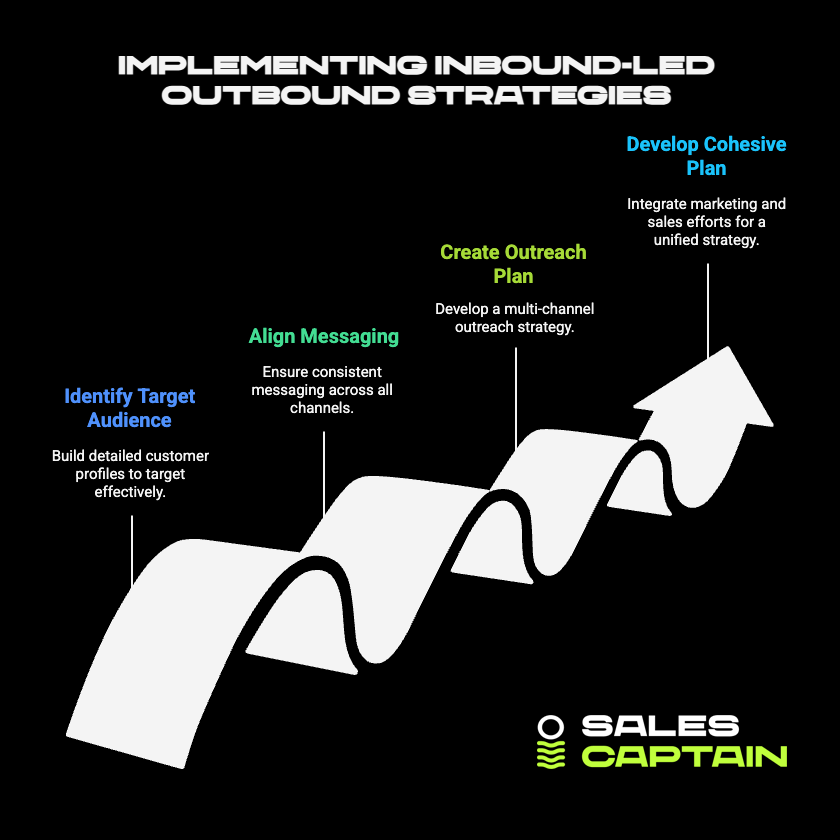
Step-by-Step Framework for Implementation
Identify Target Audience
Start with precision.
Build an ideal customer profile, but in layers. Company size, funding stage, industry, hiring signals, tech stack. Then layer in behavior, visited your blog, followed your LinkedIn, watched a customer testimonial.
Use those signals to build segmentable lists that are both high-fit and high-intent.
Align Messaging Across Channels
One email isn’t a campaign. One blog isn’t a funnel.
You need consistent messaging, across ads, video, email, socials, and outbound copy. But consistent doesn’t mean identical. It means coherent across the journey.
Your blog might explain the pain. LinkedIn breaks it down with a problem meme. Cold email calls it out in one sentence. The message lands because the story is synced.
Create a Multi-Channel Outreach Plan
Don’t rely on one channel to do it all.
Email, LinkedIn, phone, Slack communities, retargeting ads, they all play a role. Build flows where each touchpoint reinforces the others.
Outbound isn’t just a sales motion anymore. It’s marketing, sales, and ops working the same thread from different angles.
Timing matters here. Should you retarget before emailing? Hit LinkedIn after they open the email? This is why execution matters more than ideas.
Developing a Cohesive Marketing Plan
Your content should do more than rank. It should generate signals.
Track who’s reading what. Which posts trigger product comparisons. Who revisits your site twice in a week. Feed that back into outbound playbooks.
The content team isn’t separate from sales. They’re your best demand generators.
And marketing campaigns? They should set up outbound moments. If your launch campaign is about integrations, outbound should hit prospects in that ecosystem with comparison messaging.
Break the silos. Align the rhythm. Think in loops, not lines.
Leveraging Technology for Success
Essential Tools for Inbound-Led Outbound
Here’s where it gets technical.
You need tools that don’t just store data, but activate it. That means enrichment, scoring, sequencing, routing, all automated, all contextual.
Start with something like Clay. It's a master control center for sourcing, filtering, and personalization at scale. Using our link gives you 3,000 free credits to test it.
Match that with tools for sequencing (e.g. Smartlead, Instantly), tracking engagement (e.g. Mutiny or Clearbit), and enriching with real-time firmo and techno data (e.g. Apollo, LinkedIn Sales Navigator).
Not just a stack. A system.
Using CRM Systems Effectively
CRMs aren’t static anymore. They’re dynamic engines.
Assuming you're syncing inbound signals (site visits, event attendance, email clicks), your CRM becomes a trigger hub for outbound.
Visibility matters, especially between teams. Marketing should see what sequences people are in. Sales should see what content prospects consumed.
Make sure lead statuses, stage definitions, and handoff criteria are tight. If marketing says someone is MQL but sales disagrees, you're not aligned.
Your CRM should act like a control panel. Not a graveyard.
Automation and AI in Lead Management
This is where scale happens.
AI scores leads based on fit and intent. Automation routes them to the right flows automatically. Humans step in only when it matters, creating efficiency and precision.
Need to prioritize accounts who viewed your pricing but didn’t convert? Trigger outreach.
Want to resurface old leads who now match new ICP criteria? Automate that.
Inbound signals tell you who’s warm. Outbound automation brings the heat.
This is also where you stop using SDRs to do what software already can. Let reps speak to buyers. Let your workflows do the rest.
Metrics to Measure Success
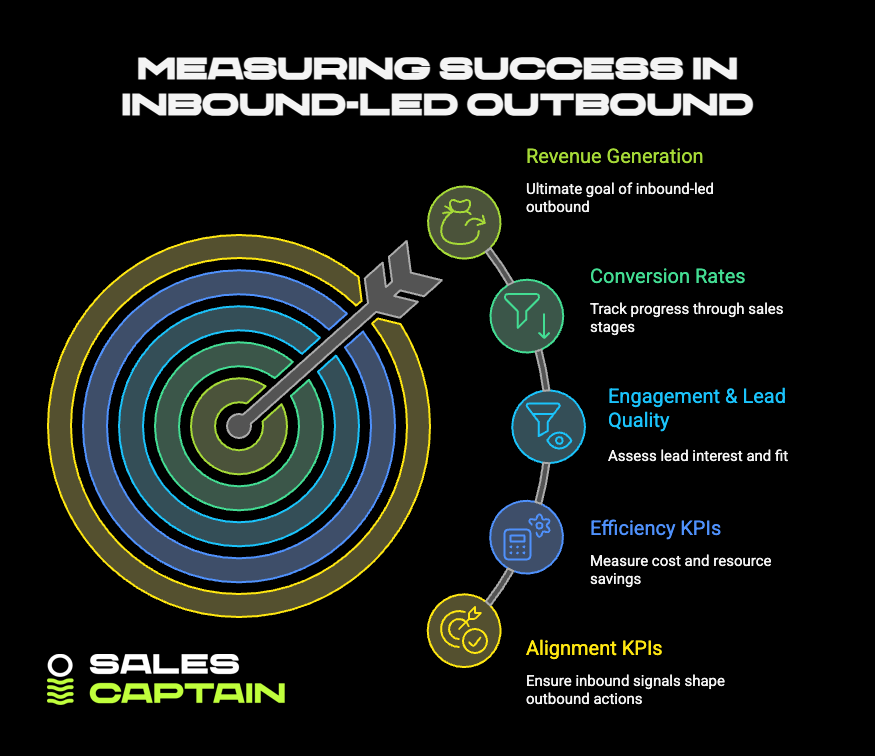
Key Performance Indicators (KPIs)
Not all metrics matter. Only the ones that show if your system is working.
For inbound-led outbound, standard funnel metrics won’t cut it. You need KPIs that tell you whether inbound signals are shaping outbound actions, and whether that loop is driving revenue.
Start with alignment KPIs:
- % of outbound leads sourced from inbound signals
- Time-to-contact after signal detection
- Message relevance scores (based on reply tone or surveys)
Then layer core pipeline KPIs:
- Response rate (on outbound triggered by inbound)
- Meeting booked rate (from signal-based sequences)
- Pipeline generated per campaign or asset
And don’t forget efficiency KPIs:
- Cost per qualified lead (inbound-initiated vs cold start)
- Rep bandwidth saved via automation
- Warm lead conversion rate vs cold outreach
The right KPIs don’t just report results. They improve outcomes by showing where the system fails.
Analyzing Conversion Rates
Conversion rates don’t lie, but they can mislead.
Don’t stop at email open or link click rates. Track end-to-end conversion tied to signal type and playbook flow. Did someone who read the pricing page convert higher after a tailored LinkedIn message? Did webinar attendees book calls faster when followed up with value-led cold emails?
Look at conversion rates across stages:
- Signal viewed → Outreach sent
- Outreach sent → Response
- Response → Meeting booked
- Meeting → Opportunity
- Opportunity → Closed/won
The gaps between those stages tell you what needs fixing. Sometimes messaging. Sometimes timing. Sometimes who you're targeting.
Also, compare outbound conversion when triggered by inbound intent versus cold outbound alone. That delta is your proof.
Tracking Engagement and Lead Quality
Not all interest is created equal.
You want engaged leads, not just active ones. Someone clicking an email isn’t the same as someone revisiting your “How We Compare” page five times in a week.
Track depth, not just frequency:
- Scroll depth on content
- Session time across buying pages
- Tool usage (if product-led triggers are present)
- Repeat interactions across channels (email, LinkedIn, site)
Then score for lead quality. High-fit company plus high-engagement behavior? That’s gold.
You’ll also want rejection signals, like high bounce rates or pushback replies on outbound. Those tell you where targeting or messaging is off.
Your GTM system should route high-quality signals into outbound flows automatically. Don’t let your best leads sit in a spreadsheet.
Common Mistakes in Inbound-Led Outbound
Ignoring Customer Insights
Just because outbound feels proactive doesn’t mean you should improvise.
Too many teams skip the research. They grab a lead list based on job title and start blasting based on assumptions. That’s not strategy, it’s guesswork.
Every outbound touch should reflect actual signals pulled from inbound, and behavioral or firmographic insights are the difference between context and noise.
What content are they reading? What product do they use? What shift did we detect on LinkedIn or Crunchbase? If you're not building outreach around those clues, you're hoping instead of selling.
Inbound-led outbound dies when you skip the "why them, why now."
Lack of Consistency in Messaging
One brand. One POV. One narrative.
That’s what your prospect should see, whether they read your blog or get hit with a cold DM.
But too many teams let marketing write one story while sales tells another. Or worse, outbound efforts recycle old templates that ignore what inbound already taught the buyer.
Consistency should live in your frameworks, not your exact words. The theme should carry all the way through: from content to comment to call.
If your prospect is hearing two different stories from your channels, they’ll stop listening to both. Misalignment kills momentum.
Failing to Nurture Leads
Just because outbound booked a meeting doesn’t mean inbound is done. Just because inbound drove a download doesn’t mean outbound should rush the pitch.
Leads need nurturing. Especially in multi-threaded B2B deals.
Sliding a prospect into a nurture flow after they no-show? Smart. Running retargeting ads to accounts you're currently emailing? Smarter.
Inbound and outbound should build momentum together. It’s not one and done. It’s always-on, each touch designed to earn the next one.
Instant demo pitches to cold leads still don’t work. Use inbound content to pull them closer until the ask makes sense.
Deals grow in the space between the touches. Most teams forget that.
Crafting Compelling Content
Types of Content for Inbound-Led Outbound
Not all content deserves a cold follow-up. Some just gets views. Others create conversation.
The best types for inbound-led outbound are signal-generators:
- Comparison pages: trigger outbound with “Why us vs X” based on views
- Customer stories: fuel follow-ups with outcome-based messaging
- Problem-focused blogs: create pain alignment for first-contact touch
- Pricing and feature content: reveal mid-funnel interest worth pouncing on
- Social posts: generate DMs based on engagement or reactions
Bottom line, create content that isn’t just useful, but trackable. Posts that reveal intent. Pages that reveal urgency.
If content carries no signal, it won't drive outbound. You're just writing into the void.
Best Practices for Engaging Your Audience
Write for conversations, not just clicks.
Every great outbound sequence should trace back to something the prospect saw, read, liked, or searched. That means your content needs to speak to real pains, not fluffy benefits.
Best practices?
- Lead with insight, not offers
- Use narrative and specificity, “How Acme Cut CAC by 42%” beats “Best Practices to Lower CAC”
- Optimize content for both humans and workflows (UTMs, custom fields, clear CTA paths)
- Make follow-up natural: if your blog explains a pain, your email should ask about how they’re solving it
Your best sales email might be your best blog, cut into snippets, repackaged, and sent with intent.
Outbound feeds off content with gravity. Build it accordingly.
Utilizing User-Generated Content
UGC is social proof with volume, perfect for fueling outbound with credibility.
That includes:
- Customer reviews from G2
- LinkedIn comments from users
- Screenshots of client results (with permission)
- Loom feedback sent by customers
- Posts where clients tag your product or team
Outbound feels less cold when it includes proof of community. “Hey, saw you liked X’s post on their wins with our platform” turns a cold open into a warm nudge.
UGC also surfaces in places where your ideal customer hangs out. That’s a signal you can work with, if you’re listening.
Use tools to monitor for those mentions. Or assign your outbound team to scout comment sections. That’s real-time opportunity sourcing.
Building Effective Communication
Aligning Sales and Marketing Teams
If sales doesn’t know what marketing launched this week, and marketing doesn’t know which sequences sales is sending, you're broken.
Inbound-led outbound only works when sales and marketing are in sync, not just in goals, but in daily execution.
Shared dashboards. Weekly stand-ups. Unified messaging doc. Whatever fits your motion, the outcome should be the same: one funnel, one conversation.
Marketing should know which sequences are working. Sales should use content that’s being consumed. No guesswork. No “who owns this” debates.
Alignment is less about org charts, more about workflows. Teams that talk ship better pipe.
Utilizing Social Selling Techniques
Social selling isn’t just liking posts and dropping emojis.
Done right, it’s one of the most powerful extensions of inbound-led outbound.
Start with inbound triggers, commenters on your content, those who engage on LinkedIn, followers of your competitors. Then go outbound in the channel they trust: DMs, comments, smart replies that add value.
The best reps act like creators. They build audience equity, then convert softly. Not “let’s book time”, more like “saw you’re thinking about X, we solved that for Y with Z.”
It’s not scaling spam. It’s scaling relationships with signal-led intent.
Social selling works best when supported by active inbound presence. That’s what gives your outreach credibility from the start.
Creating a Feedback Loop for Continuous Improvement
Campaigns that learn outperform campaigns that last.
Every outbound touch gives you data, response rate, tone, timing, persona match. Every inbound asset gives you signals, scroll time, repeat views, form fill rates.
The loop is complete when those insights shape your next move.
Here’s how to do it:
- Weekly review of asset performance tied to outbound conversions
- Regular syncing between content, outbound ops, and growth
- Feedback from sales logged and passed to marketing for content refinement
What didn’t convert this week might still teach you something.
Refine copy based on objections. Build new assets based on questions. Tweak targeting based on engagement gaps.
Your GTM system should get smarter every sprint. Otherwise you're just doing prettier outbound.
Adapting to Changes and Trends
Staying Relevant in a Dynamic Market
Your buyers shift fast. So should your system.
ICP that made sense last quarter? Might be irrelevant now. Channels that were hot last year? Might be noise today.
Inbound-led outbound gives you the agility. As new signals emerge, funding rounds, job changes, product launches, you can pivot messaging, targeting, and content instantly.
But only if you’re watching.
Build workflows that surface shifts in real-time. Build content fast enough to respond. Let your ops flow respond faster than annual planning decks.
Markets move quick. Relevance is rented.
Experimenting with New Tactics
Best practices aren’t enough. Every now and then, you’ve got to break your own playbook.
Try new triggers: podcast guest appearances, newsletter sponsorships, Slack group interactions.
Test new formats: outbound audio snippets, DM-first campaigns, TikTok-style video walkthroughs.
Experiment doesn’t mean chaos. It means carving 10 to 15 percent of your motion for bets with upside. Small batch tests let you find signal before everyone else does.
Playbooks age. Systems experiment.
Learning from Industry Leaders
GTM evolves faster when you're learning sideways.
Follow what fast-moving companies are doing publicly. Clone what agencies like SalesCaptain use to drive full-funnel outbound for dozens of clients. Watch play breakdowns on LinkedIn from operators who’ve scaled from $0 to $20M ARR.
But don’t just copy tactics. Study the architecture. How are they connecting inbound to outbound? How do they use data to decide who to hit, when, and with what?
That stuff won’t be in ebooks. It’s in Slack messages, Notion docs, and Loom walkthroughs, shared by the people who build real systems.
Those are the people worth learning from.
Trends change. But the best operators build systems that adapt on their own.
Practical Tools and Resources
Checklists for Implementation
Inbound-led outbound isn't just strategy, it’s execution. And execution thrives on clarity.
Here’s a tactical checklist to help you go from idea to pipeline:
- Define ICP with Signal Triggers
- Industry, size, funding, roles, tech stack
- Behavior: visits pricing page, downloads guide, engages on social
- Firmo/techno/intent layers in your data model
- Map Content Assets to Funnel Stages
- Problem = blog, social post, webinar
- Comparison = feature page, video walkthrough
- Trust = case study, testimonial, G2 review
- Build Channel-Specific Workflows
- Cold email copy pulled from what page they viewed
- LinkedIn scripts based on role and stage
- Retargeting ads synced with content viewed
- Sequence Campaigns Around Inbound Triggers
- E.g. "Visited pricing + didn’t submit form → LinkedIn DM + email in 24h"
- Operational Checks
- CRM fields mapped for tracking signal type
- Automation rules for routing leads post-trigger
- Sequence testing across personas
Execute in loops, test, learn, rebuild. These checklists aren’t for checkboxes. They’re for reps who want to stop shooting blind.
Recommended Software and Platforms
No solo tool wins the game. It takes a stack, but a smart one.
Start with Clay. This is where your GTM stack should orbit around. Clay lets you pull in real-time data from dozens of sources, filter by signals, personalize at scale, and launch workflows, all without code. Our link gives you 3,000 free credits to get started.
Other tools to plug in based on motion:
- Sequencing & Outreach: Instantly, Smartlead
Run outbound sequences that pivot based on engagement and intent. - Trigger Signals: Clearbit, Factors.ai, Leadfeeder
Know who’s on your site, what they’re doing, and where they're dropping. - CRM: HubSpot, Salesforce
But only when wired correctly. The goal isn't storage, it's trigger logic. - Data Enrichment: Apollo, ZoomInfo, LinkedIn Sales Navigator
No signal = no action. Good enrichment makes personalization real. - Attribution & Feedback: Dreamdata, HockeyStack
Especially useful for closing the loop, what content fed what outbound deal?
Don’t confuse stack with system. A system connects, automates, adapts. Tools are just the parts.
Accessing Industry Reports and Research
If you're driving strategy without benchmarks, you're building in the dark.
Inbound-led outbound thrives on timing, trends, and tactics that evolve fast. The good news? There's no shortage of data, if you know where to look.
Key sources to keep in rotation:
- Gartner & Forrester: Great for high-level GTM and SaaS buyer behavior shifts, but often behind paywalls.
- State of Outbound Reports (Smartlead, Clay, Salesloft): Emerging insights on reply rates, personalization trends, and tooling impact.
- LinkedIn & Twitter threads from GTM operators: Some of the most actionable advice won’t be in PDFs, it’s in threads, Looms, and teardown posts. Follow RevOps leaders who actually publish their workflows.
- Open startup reports (Baremetrics, ProfitWell): Great for seeing how growth-stage companies handle pipeline and channel experimentation.
- SalesCaptain outbound benchmarks: Agencies like SalesCaptain run dozens of outbound engines across industries, if they publish even a glimpse of open/click/book rates tied to signal sourcing, you study it.
Use research not just to inspire, but to diagnose. If your metrics fall short, don’t tweak the email. Rebuild the system.
FAQs
It’s the intersection where content meets tig.
Inbound-led outbound uses inbound signals, whIt’s the intersection where content meets timing.
Inbound-led outbound uses inbound signals, who viewed what, when, and why, to trigger outbound actions. Instead of mass spraying, you reach out to the right prospects with the right message at the exact moment they show intent.
It’s not a hybrid strategy. It’s a feedback loop.
An ideal example? Prospect reads a comparison page, exits. Next day, they get a concise LinkedIn DM referencing the exact product they were comparing. That’s precision at scale.
Outbound becomes smarter. Inbound becomes actionable. Revenue follows.
o iewed what, when, and why, to trigger outbound actions. Instead of mass spraying, you reach out to the right prospects with the right message at the exact moment they show intent.
It’s not a hybrid strategy. It’s a feedback lop
An ideal example? Prospect reads a comparison page, exits. Next day, they get a concise LinkedIn DM referencing the exact product they were comparing. That’s precision at scale.Outbound becomes smarter. Inbound becomes actionable. Revenue follows.
Start small, but plan like a system.
- Set up signal tracking: Know who’s viewing your high-intent content.
- Enrich that data: Add company size, tech stack, hiring trends.
- Map signals to outbound actions: Which trigger gets an email, a DM, a retargeting ad.
- Write sequences with context: Reference what they did, not just who they are.
- Automate routing: Use workflows to move warm leads from inbox to action without delay.
Pilot one signal-flow pair. Like: “visited pricing page + Series A company → 3-touch outbound nurture.” See what hits. Then scale sideways.
Inbound-led outbound isn’t complex, but it does require choreography.
The best tools act like operators, not just features.
Use Clay as your base layer. It pulls and merges data from multiple sources in real-time, then lets you personalize and launch workflows from inside the UI. With the free credits from our link, you can test high-volume plays immediately.
Beyond Clay:
- Sequencers: Smartlead or Instantly, for conditionally triggered campaigns.
- Website tracking: Clearbit Reveal, Factors.ai to surface high-intent visitors.
- CRM integrations: HubSpot/Salesforce must trigger actions, not just store leads.
- Slack/Email alerts: Funnel signal data to sellers instantly so timing stays tight.
The goal is flow, not just stack clutter. Every tool should be part of the lead-identify-activate loop.
Forget broad vanity metrics. Success in inbound-led outbound lives at the intersection of signal and outcome.
The key is attribution with context:
- Did that outbound reply come from someone who first clicked your competitor guide?
- Was the demo booked from a prospect who watched half your onboarding walkthrough?
- What’s the conversion delta between signal-triggered sequences and cold outbound?
Use these metrics to get a clean read:
- % of outbound activity initiated by inbound signals
- Conversion rate from viewed content to booked meeting
- Reply sentiment and personalization match score
- Pipeline generated per signal type (e.g., pricing page vs feature blog)
If your outbound isn't moving faster, feeling warmer, or converting higher, something's misaligned.
The system should be catching signals, reacting instantly, and tightening time to value.
If not, your funnel’s leaking where it should be sprinting.
RELATED ARTICLES
Check out more articles on our blog!
RELATED ARTICLES
Lorem ipsum dolor sit amet, consectetuer adipiscing elit, sed diam nonummy nibh euismod tincidunt ut laoreet dolore magna aliquam erat volutpat.
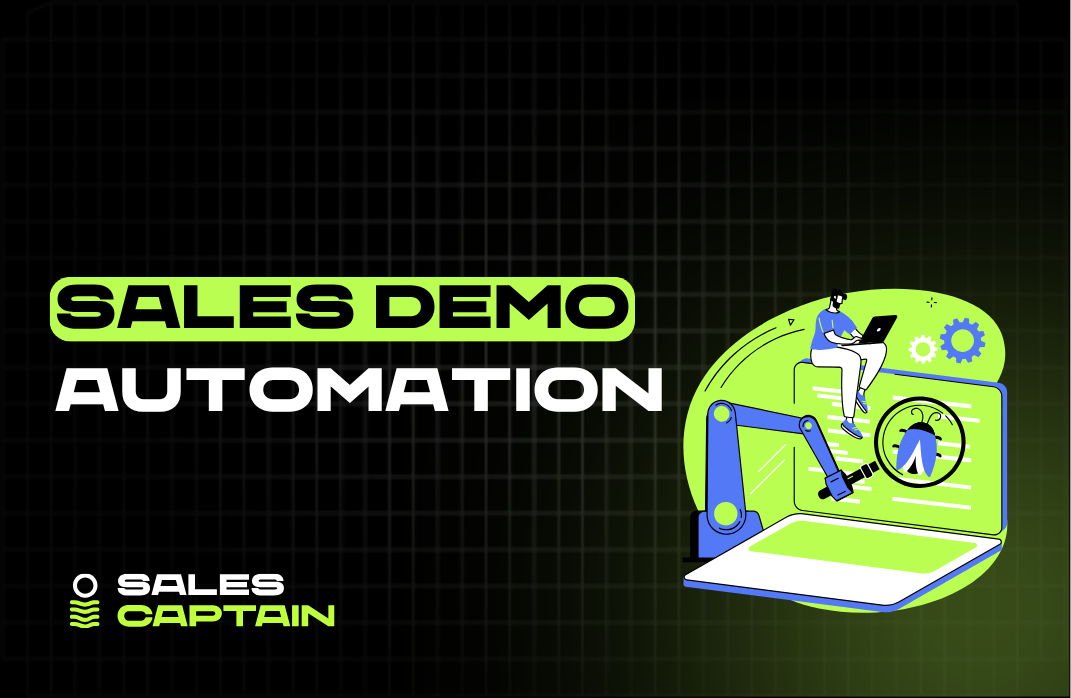
.png)


.jpg)


